Ireland celebrates Saint Patrick every March 17. But how many of us can really say that we know who he is – or who he was – and how relevant he is in today's secular and, for the most part, pagan society?
Saint Patrick is not only the Patron Saint of Ireland, but he is also the Patron Saint of Australia, Nigeria, and Montserrat, which gives him universal recognition in the Church and in the world. He is also "Apostle" by God's design to the Irish worldwide in the same genre as Saint Paul was "Apostle to the Gentiles."
Saint Patrick becomes the Patron Saint on March 17 in almost every country of the world, as people celebrate their "Irish-ness" or links with Ireland through family and friends.
Saint Patrick is probably the best-known saint around the world, after Saint Therese of Lisieux. Not only are many people named after him, with some 7 million bearing his name, but many establishments, institutions, and churches are called after him. Saint Patrick's Cathedral in New York is the most famous of all.
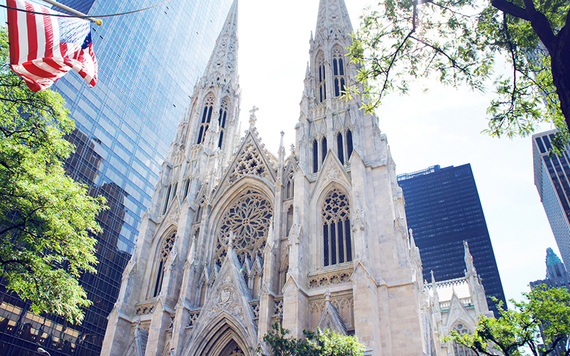
St. Patrick's Cathedral in New York. Photo: iStock
St. Patrick's kidnapping and imprisonment in Ireland
By all historical accounts, Patrick was captured by an Irish raiding party somewhere along the west coast of what is known today as Great Britain. It was more than likely Scotland because of its proximity to Ireland, although many would say Wales. We know that there were boats leaving from Strangford Lough in Larne at that time, around the year 426 AD. (One can see Scotland from Larne on a clear day; it's about 10 miles away).
Raiding parties, with warriors known as the "Picts," would land somewhere on the coast and, if the place was inhabited, would usually do a "smash and grab job" of looting – young people, animals, clothes, weapons, etc. – and if they were opposed by anyone, they would kill them in order to get what they wanted. They were able to run inland for about three miles non-stop while leaving a handful of men to guard their vessels.
On one such raid, Patrick was snatched and brought to Ireland as a slave. His job was to mind the sheep at night in case wolves, wild dogs, foxes or even wild bears would take them or their lambs. He did this on the slopes of the Slemish Mountains in County Antrim.
We know from our history that Patrick's father was a deacon and, therefore, a good Catholic. He was one who taught the faith in his own community, and no doubt one who prayed unceasingly for Patrick in a special way after his son's kidnapping, asking the Lord for his safe return.
(We know some of the sources that give testimony to these facts from Patrick's "Confessions," the "Epistle against Coroticus", and a number of "Ancient Lives," including the Book of Armagh II, held in Trinity College Dublin).
How St. Patrick returned home and became a priest
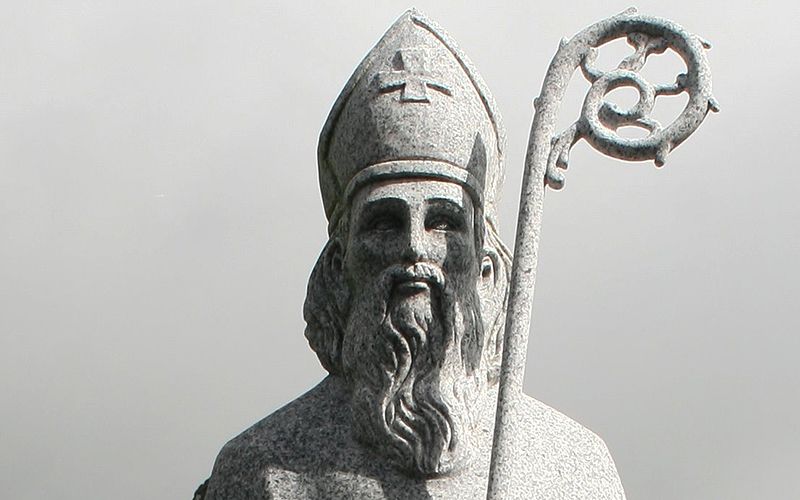
St. Patrick's Statue in Aghagower, Co. Mayo. Photo: Andreas F. Borchert, Wikimedia Commons.
Although Patrick was only 16 years old when taken into slavery, he was able to escape six years later and return home. He recounts a "dream" (vision) he had, in which an angel of the Lord came in the night, and told him of a ship that was leaving Ireland, and how he might be able to take it by traveling south, near Dublin.
By this time, Patrick, who was often cold and hungry, had spent six years in virtual isolation away from people. He was lonely and had turned to prayer and, like his father, had prayed non-stop asking God to deliver him. His prayers were finally heard and God had designs on him. In fact, it would be fair to say, that Patrick had become somewhat of a mystic by this stage, so intense was his prayer life and his constant communication with God.
He arrived home to the delight of his parents and was reunited with his family and friends. He later began to realize that he had a vocation to the priesthood or some ministry of prayer in the Church. At this time the Church was already established somewhat in Ireland. There was already an Archbishop of Armagh by the name of Pallidus.
Ireland was not ecclesiastically independent at the time but came under the ecclesiastical jurisdiction of Arles in France, which is connected to the great Mediterranean Sea by the Rhone River and from there by a direct link to Rome.
Patrick often thought about the Irish and prayed for their conversion to the faith. During his time in Ireland, even though he was a slave, he had developed a profound relationship with God and a great ability to pray.
Later, as he said himself in his "Confessions," he was tormented by the "Voice of the Irish," whom he had heard calling in the night: "Come back to us Patrick."
St. Patrick's great mission to Ireland and the arrival of civilization
Once Patrick was ordained as a priest and had learned Latin and French, he asked to be sent as a missionary to Ireland, or, as it was known then, Hiberniae, which means the "Land of Winter." Patrick had a great missionary zeal and soon became Ireland's second Archbishop of Armagh and Primate of all Ireland.
He set two goals for himself: first, to evangelize the pagan Irish, and second, to set up the ecclesiastical structures and dioceses with a view to achieving independence from Arles, which was supporting the missionary activity in Ireland up until that time.
To do this without modern communications, roads, rail, telecommunications, etc. was very difficult, but Patrick was not deterred by hardship. After all, he was on fire with the love of God in his heart. He knew what his mission would be, and how difficult it was, but he trusted always in the power of God to deliver him, and so he went about evangelizing. He did this by setting up many quasi-monastic structures in towns and villages when he passed through them.
He preached daily about the Kingdom of Heaven and baptized those who accepted the Gospel. Those who excelled in their faith, he ordained to the diaconate, leaving them in charge of the prayer and the various liturgical ceremonies, while in many cases he ordained many devout men to the priesthood.
Later he was able to select from them good and brave men whom he consecrated as bishops with the approval of the Pope. He was also successful in setting up dioceses in larger towns as he journeyed throughout the island of Ireland.
Saint Patrick had laid the foundations not only for the Catholic Church in Ireland but for all of Western Europe and as such deserves the title, yet to be bestowed, of Co-Patron of Europe along with Saint Benedict, Saint Teresa Benedicta of the Holy Cross (Edith Stein), and Saint Bridget of Sweden.
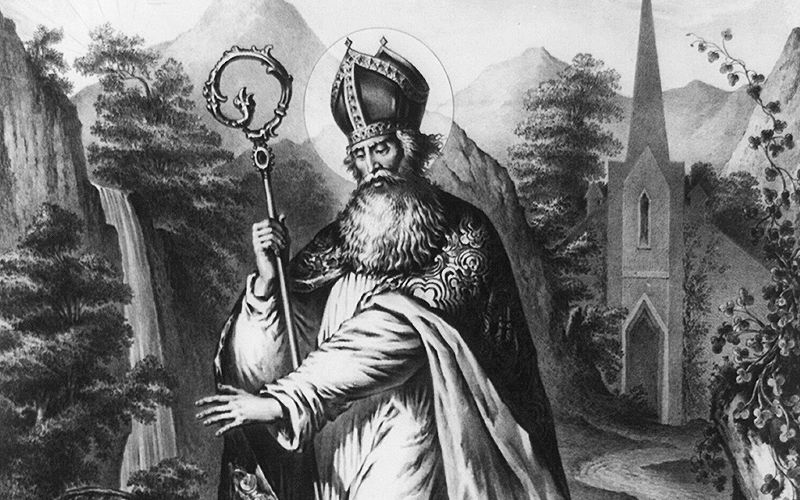
St. Patrick had laid the foundations for the Catholic Church in Ireland. Image: Library of Congress
The Catholic Church in Ireland evangelized and educated its own people first and provided the first organized educational infrastructure for a society that previously had none. The monasteries were built and there were plenty of vocations to the priesthood and the religious life.
The Irish monks became teachers and inventors. They were, in addition to leading the monastic life of prayer, also great builders and craftsmen. Given that there were so many vocations, they began to look at the possibilities of becoming missionaries not only to Europe but to the Americas.
Many monk missionaries left Ireland well prepared, some bound for Scotland, where they set up a monastery on Iona. Still others went to France, establishing the famous monastery of Locmine in Brittany, which still exists. Others went to Spain and Saint Brendan the Abbot even went to North America (474-577AD).
Saint Patrick realized that the word Christianization was synonymous with civilization and, therefore, as Europeans were being evangelized, they were at the same time being civilized. Europeans eventually became educated and were able to build the big monasteries and cathedrals, many of which still exist. This is due initially to the untiring efforts of Saint Patrick and those great missionaries who are, for the most part, forgotten by the Irish of today. Saint Patrick himself is really a gift of God to the Irish people for whom the Irish will be eternally grateful.
Saint Patrick died in Armagh in 461AD after 29 years as Archbishop in that Archdiocese which now has the Primacy of all Ireland. The current Archbishop is known as "Primate of all Ireland." His job would be to chair all meetings of the Irish Episcopal Conferences and to make sure that faith and morals are taught and upheld by both the religious and civil authorities.
The remaining relics of Saint Patrick and his gifts to Ireland
There exists a very precious relic of Saint Patrick in Northern Ireland, his incorrupt right hand. This sacred and special relic is, unfortunately, kept in the Ulster Museum and not in a dedicated or special place which is open to pilgrims.
Saint Patrick's jaw is kept in a parish church in the Diocese of Down and Connor. His grave is beside the Cathedral of Armagh.
Hopefully, one day these relics will be gathered together and incorporated into an International Shrine of Saint Patrick, along with all the other materials, such as books on his life, etc., which show his influence on the entire Catholic Church.
To celebrate Saint Patrick's Day, therefore, is to commemorate his life and works and to give thanks to God for the gift of this great saint, while imploring him to intercede on our behalf before the Most Blessed Trinity. According to a legend, Saint Patrick used the shamrock to try to explain how there can be Three Divine Persons in one God, because, as we all know, there are three leaves in one stem on the shamrock.
Patrick is also the one who left us with the Celtic Cross. When he began to evangelize he found that many of the pagans had worshiped the sun and so he incorporated the sun into the Latin Cross. Likewise, when he met the Druids, who worshiped a sacred standing stone that was marked with a circle that was symbolic of the moon goddess, he incorporated that also. The Celtic Cross is now world-famous and revered by all.
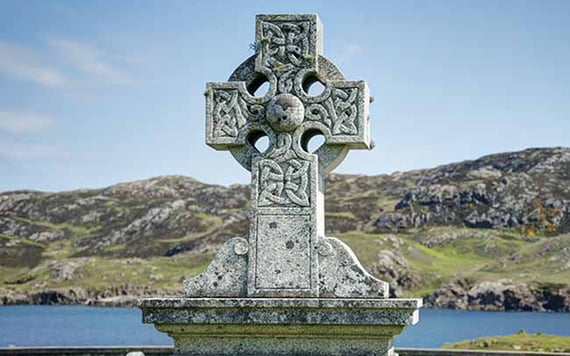
The Celtic Cross envisioned by St. Patrick. Image: Getty.

Love Irish history? Share your favorite stories with other history buffs in the IrishCentral History Facebook group.
"Saint Patrick's Breastplate" - a prayer of protection written by St. Patrick himself
I arise today
Through a mighty strength, the invocation of the Trinity,
Through the belief in the threeness,
Through confession of the oneness
Of the Creator of Creation.
I arise today
Through the strength of Christ's birth with his baptism,
Through the strength of his crucifixion with his burial,
Through the strength of his resurrection with his ascension,
Through the strength of his descent for the judgment of Doom.
I arise today
Through the strength of the love of Cherubim,
In obedience of angels,
In the service of archangels,
In hope of resurrection to meet with reward,
In prayers of patriarchs,
In predictions of prophets,
In preaching of apostles,
In faith of confessors,
In innocence of holy virgins,
In deeds of righteous men.
I arise today
Through the strength of heaven:
Light of sun,
Radiance of moon,
Splendor of fire,
Speed of lightning,
Swiftness of wind,
Depth of sea,
Stability of earth,
Firmness of rock.
I arise today
Through God's strength to pilot me:
God's might to uphold me,
God's wisdom to guide me,
God's eye to look before me,
God's ear to hear me,
God's word to speak for me,
God's hand to guard me,
God's way to lie before me,
God's shield to protect me,
God's host to save me
From snares of devils,
From temptations of vices,
From everyone who shall wish me ill,
Afar and anear,
Alone and in multitude.
I summon today all these powers between me and those evils,
Against every cruel merciless power that may oppose my body and soul,
Against incantations of false prophets,
Against black laws of pagandom
Against false laws of heretics,
Against craft of idolatry,
Against spells of witches and smiths and wizards,
Against every knowledge that corrupts man's body and soul.
Christ to shield me today
Against poison, against burning,
Against drowning, against wounding,
So that there may come to me abundance of reward.
Christ with me, Christ before me, Christ behind me,
Christ in me, Christ beneath me, Christ above me,
Christ on my right, Christ on my left,
Christ when I lie down, Christ when I sit down, Christ when I arise,
Christ in the heart of every man who thinks of me,
Christ in the mouth of everyone who speaks of me,
Christ in every eye that sees me,
Christ in every ear that hears me.
I arise today
Through a mighty strength, the invocation of the Trinity,
Through belief in the threeness,
Through confession of the oneness,
Of the Creator of Creation. Amen!
* Originally published in August 2016. Updated in March 2025.
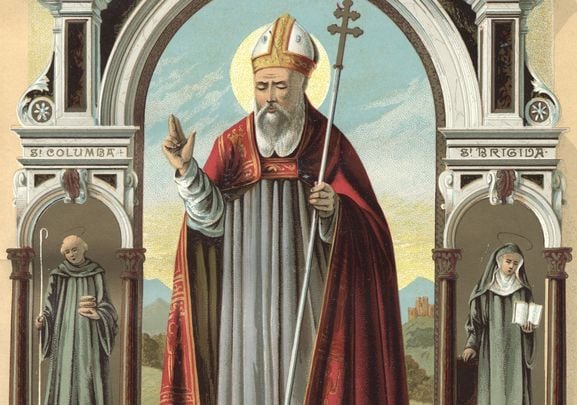
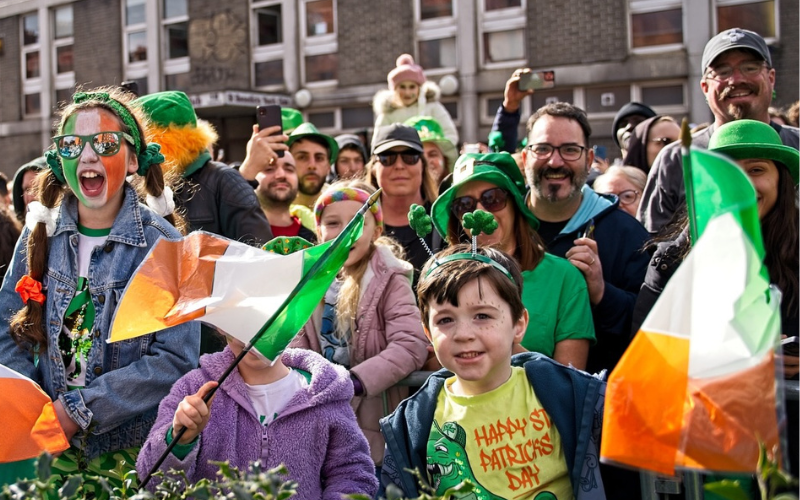
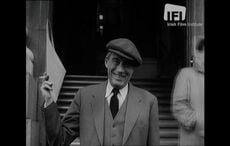
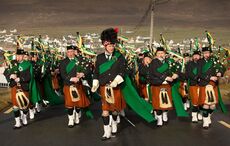
Comments